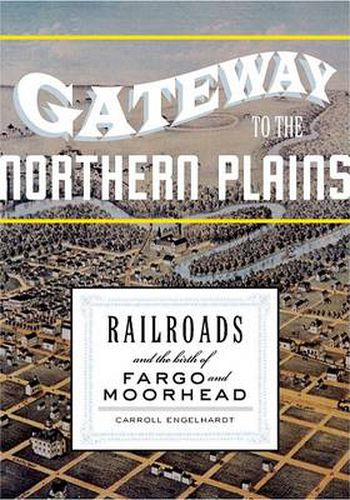Readings Newsletter
Become a Readings Member to make your shopping experience even easier.
Sign in or sign up for free!
You’re not far away from qualifying for FREE standard shipping within Australia
You’ve qualified for FREE standard shipping within Australia
The cart is loading…






In the 1860s, land speculators in Minnesota and the Dakota Territory expected that a great city would rise where the railroad crossed the Red River of the North. In 1872, after the Northern Pacific Railroad laid its first tracks across the river, it brought settlers, capital, and access to Eastern markets and gave birth to the twin cities of Moorhead and Fargo.
Historian Carroll Engelhardt’s Gateway to the Northern Plains chronicles the story of Fargo and Moorhead’s birth and growth. Once just specks on the vast landscape of the Northern Plains, these twin cities prospered, teeming with their own dynamic culture, economy, and politics. Moorhead was the first, boosted by railroad manager Thomas Hawley Canfield, who touted it as superior to Fargo. Amid disputes and deals with entrepreneurs, the railroad company provided land for public schools and churches to speed the refinement of the settlement. Despite Moorhead’s earlier start, Northern Pacific Railway chose Fargo as its headquarters, and it became the Gateway City to North Dakota.
Development in the cities was not always harmonious. As the population increased, so did the pressure to conform to middle-class values. Residents joined together to create community churches and schools, clashing with migratory harvest workers, usually single men, who patronized saloons, brothels, and gambling dens. Outraged citizens worked to eliminate such antisocial behavior and establish moral order.
Though the dominant Twin Cities to the south limited Fargo and Moorhead’s size and success, settlers from far and wide poured in, creating a diverse population and vital culture. There are many histories of major U.S. cities, but in Gateway to the Northern Plains Engelhardt reveals how the small cities of the plains have made their mark on the country as well as on the reality-and the myth-of the American West.
Carroll Engelhardt is professor emeritus of history at Concordia College, Moorhead. He is the author of On Firm Foundation Grounded: The First Century of Concordia College (1891-1991).
$9.00 standard shipping within Australia
FREE standard shipping within Australia for orders over $100.00
Express & International shipping calculated at checkout
In the 1860s, land speculators in Minnesota and the Dakota Territory expected that a great city would rise where the railroad crossed the Red River of the North. In 1872, after the Northern Pacific Railroad laid its first tracks across the river, it brought settlers, capital, and access to Eastern markets and gave birth to the twin cities of Moorhead and Fargo.
Historian Carroll Engelhardt’s Gateway to the Northern Plains chronicles the story of Fargo and Moorhead’s birth and growth. Once just specks on the vast landscape of the Northern Plains, these twin cities prospered, teeming with their own dynamic culture, economy, and politics. Moorhead was the first, boosted by railroad manager Thomas Hawley Canfield, who touted it as superior to Fargo. Amid disputes and deals with entrepreneurs, the railroad company provided land for public schools and churches to speed the refinement of the settlement. Despite Moorhead’s earlier start, Northern Pacific Railway chose Fargo as its headquarters, and it became the Gateway City to North Dakota.
Development in the cities was not always harmonious. As the population increased, so did the pressure to conform to middle-class values. Residents joined together to create community churches and schools, clashing with migratory harvest workers, usually single men, who patronized saloons, brothels, and gambling dens. Outraged citizens worked to eliminate such antisocial behavior and establish moral order.
Though the dominant Twin Cities to the south limited Fargo and Moorhead’s size and success, settlers from far and wide poured in, creating a diverse population and vital culture. There are many histories of major U.S. cities, but in Gateway to the Northern Plains Engelhardt reveals how the small cities of the plains have made their mark on the country as well as on the reality-and the myth-of the American West.
Carroll Engelhardt is professor emeritus of history at Concordia College, Moorhead. He is the author of On Firm Foundation Grounded: The First Century of Concordia College (1891-1991).